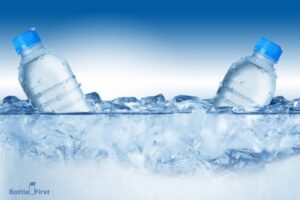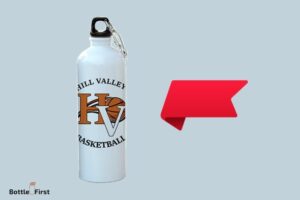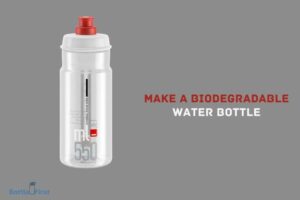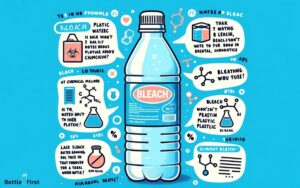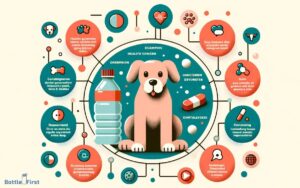Can I Fill My Water Bottle in French? Yes, Explain!
Yes, you absolutely can fill your water bottle in France. Many cities in France have public drinking fountains where you can fill your water bottle for free.
France has a well-developed and widely accessible potable water system. Many tourist spots, parks, and public areas in French cities have drinking water fountains, often indicated by “Eau Potable” signs.
They are installed to encourage the use of reusable water bottles and reduce plastic waste.
When in France, always keep your reusable water bottle handy. You can easily fill it up at various public drinking fountains, most often marked with an “Eau Potable” sign.
This practice is not only environment-friendly, but it also allows you to appreciate the often charming and historical design of these fountains.
Essential French Phrases: Filling Your Water Bottle
| English Phrase | French Translation |
|---|---|
| Can I fill my water bottle? | Puis-je remplir ma bouteille d’eau? |
| Where is the water fountain? | Où est la fontaine d’eau? |
| I need to fill my water bottle. | J’ai besoin de remplir ma bouteille d’eau. |
| Is the water safe to drink? | L’eau est-elle sûre à boire? |
| Can I fill my water bottle here? | Puis-je remplir ma bouteille d’eau ici? |
| I am looking for a place to fill my water bottle. | Je cherche un endroit pour remplir ma bouteille d’eau. |
| Can I use this tap water? | Puis-je utiliser cette eau du robinet? |
| Is this water fountain for public use? | Cette fontaine d’eau est-elle destinée à un usage public? |
Key Takeaway
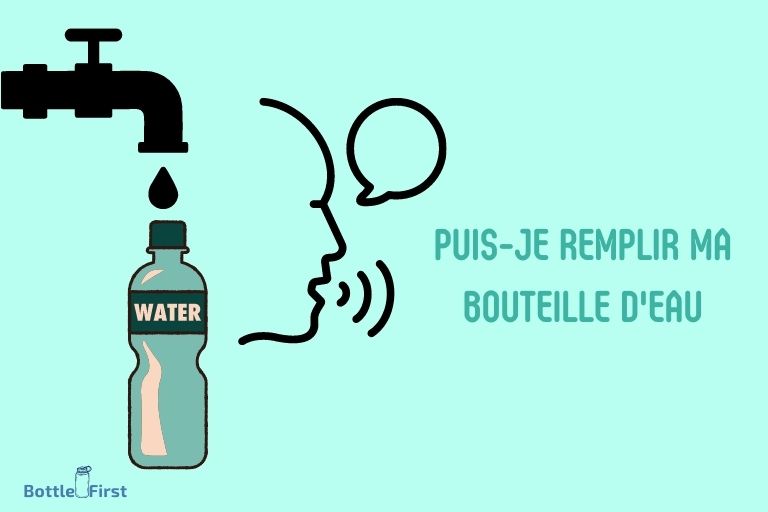
Five Facts About: Filling Your Water Bottle in French
Drinking Water In France
France is not only known for its iconic landmarks and exquisite cuisine but also for the quality and safety of its tap water.
In this section, we will delve into the key aspects of drinking water in france, including tap water quality and safety, guidelines for drinking tap water, and the availability of public water fountains.
Tap Water Quality And Safety In France
- France has one of the highest standards for tap water quality and safety in the world. The government strictly regulates the water supply to ensure it meets the highest health standards.
- The water is tested regularly for various contaminants, including bacteria, chemicals, and heavy metals. This rigorous testing ensures that the tap water is safe for consumption.
- France has an extensive infrastructure for water treatment and distribution, ensuring that the water that comes out of the taps is clean and sanitary.
Guidelines For Drinking Tap Water In France
- It is generally safe to drink tap water in france. The quality standards set by the government ensure that the water is safe for consumption. However, it is always a good idea to take necessary precautions.
- If you are staying in an older building or in rural areas, it is recommended to use a water filter to further enhance the quality of tap water.
- To avoid any potential stomach upset, it is advisable to drink bottled water when dining out in restaurants that have a questionable hygiene rating.
- If you have any concerns about the tap water quality in your specific area, you can contact the local water service provider for more information.
Availability Of Public Water Fountains In France
- France is known for its beautiful public spaces, and it comes as no surprise that public water fountains are readily available throughout the country.
- These water fountains can be found in parks, on busy streets, and near landmarks, providing locals and tourists with a convenient and sustainable alternative to bottled water.
- It is recommended to carry a reusable water bottle and refill it at these public water fountains to stay hydrated while exploring the charming streets of france.
- Some of the public water fountains in france even dispense both still and sparkling water, adding a touch of luxury to your hydration needs.
Tap water in france is generally safe to drink thanks to stringent regulations and regular testing.
By following the guidelines and utilizing the availability of public water fountains, you can confidently stay hydrated while enjoying the wonders of this beautiful country.
Carrying And Refilling Water Bottles In France
France is not only renowned for its magnificent architecture and delectable cuisine, but also for its dedication to environmental conservation.
As an eco-conscious traveler, you may wonder about the convenience of carrying and refilling your water bottle while exploring this enchanting country.
In this section, we’ll delve into the eco-consciousness surrounding the use of reusable water bottles in france, discuss the practicality of carrying a water bottle during your adventures, and highlight convenient places where you can refill your bottle throughout the country.
Eco-Consciousness And The Use Of Reusable Water Bottles In France
France, with its strong commitment to environmental sustainability, encourages the use of reusable water bottles as a means to minimize plastic waste.
Here are some key points to keep in mind:
- France has implemented a ban on single-use plastic water bottles in many public establishments, promoting a shift towards reusable alternatives.
- Reusable water bottles are readily available for purchase at various retailers in france, making it convenient to obtain one if you don’t already have your own.
- Choosing to carry a reusable water bottle aligns with the eco-conscious values of the french, showcasing your commitment to sustainability during your travels.
Carrying A Water Bottle While Exploring France
Having a water bottle readily available as you explore the remarkable sights and vibrant streets of france can offer numerous benefits.
Consider the following:
- Staying hydrated is crucial, especially during warm summer months or long walks through picturesque landscapes.
- Carrying a water bottle allows you to quench your thirst whenever the need arises, without having to purchase single-use plastic bottles.
- Save money by refilling your water bottle instead of buying expensive bottled water from vendors.
Where To Refill Water Bottles In France
Fortunately, france boasts numerous options for refilling your water bottle conveniently throughout the country.
Here are some suggestions:
- Look out for public water fountains located in parks, squares, and bustling city centers. They often provide drinkable water and offer a quick, accessible refill option.
- Many public toilets in france have sinks equipped with potable water, providing an alternative for refilling your bottle when necessary.
- Cafes, restaurants, and other dining establishments are often willing to refill your water bottle, especially if you’re a customer.
- Refill stations known as “fontaine à eau” or “fontaine de rue” can be found in larger cities, allowing you to refill your bottle with ease.
By carrying a reusable water bottle while exploring france and taking advantage of the various refill options available, you can both embrace the country’s eco-conscious mindset and ensure you stay hydrated during your unforgettable adventures.
Cultural Practices And Etiquette
French Attitudes Towards Drinking Water In Public Spaces
Drinking water is an essential part of our daily lives, and understanding cultural practices and etiquette in different countries can help us navigate and respect local customs.
When it comes to filling your water bottle in france, there are a few things to keep in mind.
Let’s explore the french attitudes towards drinking water in public spaces, restaurants and cafes, as well as tourist attractions and public transportation.
Drinking Water In Restaurants And Cafes In France
In restaurants and cafes in france, it is common practice for customers to order bottled or sparkling water from the menu.
Tap water is not typically offered automatically and may need to be specifically requested.
Here’s what you need to know about drinking water in restaurants and cafes:
- French tap water is generally considered safe to drink, but offering tap water for free is not a common practice in many establishments.
- It is advisable to order bottled water or opt for other beverages like wine, coffee, or soda which are typically available for purchase.
- If you prefer tap water, you can politely ask for “une carafe d’eau” (a carafe of water) or “un verre d’eau du robinet” (a glass of tap water).
Drinking Water In Tourist Attractions And Public Transportation
When visiting tourist attractions or using public transportation in france, finding water sources might require a bit of planning.
While most tourist sites do offer amenities like cafes and restaurants, it’s important to be prepared.
Here’s what you need to know about drinking water in tourist attractions and public transportation:
- Tourist attractions often have water fountains or refill stations available. Look out for signs indicating these amenities.
- Some attractions may not allow outside food or drinks, so it’s best to check the rules beforehand.
- Public transportation systems like buses, trams, and trains generally do not provide free water. It’s advisable to carry a reusable water bottle and fill it up before your journey or during stops at cafes or shops.
Remember, it’s always a good idea to stay hydrated, especially when exploring new places, so make sure to plan accordingly and have a water bottle with you on your adventures in france.
Language Challenges And Solutions
Common French Phrases For Asking To Fill A Water Bottle
- “puis-je remplir ma bouteille d’eau ici?” (can i fill my water bottle here?)
- “est-ce que je peux obtenir de l’eau pour ma bouteille?” (can i get water for my bottle?)
- “pourrais-je demander à remplir ma bouteille d’eau?” (may i ask to fill my water bottle?)
- “est-il possible de remplir ma bouteille d’eau?” (is it possible to fill my water bottle?)
- “est-ce qu’il y a un endroit où je peux remplir ma bouteille d’eau?” (is there a place where i can fill my water bottle?)
- “serait-il possible de remplir ma bouteille d’eau ici?” (would it be possible to fill my water bottle here?)
- “je recherche un robinet pour remplir ma bouteille d’eau.” (i’m looking for a tap to fill my water bottle.)
How To Request Tap Water In Restaurants And Cafes
- Politely ask the server or waiter for a glass of tap water.
- Specify that you would like it in a separate glass to fill your water bottle.
- Express gratitude by saying “merci beaucoup” or “thank you very much.”
Overcoming Language Barriers While Searching For Water Sources
- Carry a portable translator or language translation app to communicate your needs effectively.
- Use simple and universal gestures, such as pointing at your water bottle or miming filling it up.
- Learn a few basic french phrases beforehand to assist in navigating language barriers.
- Approach locals or friendly passersby who may be willing to help understand and direct you to a water source.
- Seek public places like parks, shopping centers, or train stations, as they often provide water fountains or public taps.
- Research places beforehand that offer free water, such as public libraries or community centers, as these may be more accessible and english-friendly.
Remember, overcoming language barriers can be challenging, but with a few phrases and creative communication strategies, you’ll be able to fill your water bottle in french without any hassle.
Enjoy your travels and stay hydrated!
Alternatives To Tap Water
In france, if you are wondering about alternatives to tap water, there are a few options available.
Whether you want to buy bottled water, try other beverage options, or carry alternative forms of hydration during your travels, there are choices to suit your preferences.
Buying Bottled Water In France:
Bottled water is readily available in france, and you can find it at various grocery stores, convenience stores, and even vending machines.
Here are some key points to consider:
- Look for bottled water labeled “eau minérale” which means mineral water. France is known for its natural mineral springs, and some brands offer an assortment of mineral-infused water options.
- Popular brands such as evian, volvic, and perrier are widely available and trusted for their quality. You can choose from still or sparkling water based on your preference.
- Keep in mind that buying bottled water may not be the most environmentally friendly option, as it generates plastic waste. Consider recycling the bottles or using a reusable bottle instead.
Other Beverage Options In France:
Apart from bottled water, france offers a range of delicious and refreshing beverages.
Consider these options as alternatives to tap water:
- Wine: France is renowned for its wine production, and enjoying a glass of local wine can be a delightful experience. From red to white to rosé, there is a wine to suit every taste.
- Fruit juices: France is known for its fresh and flavorful fruit juices. Try the classic orange juice or explore options like apple, grape, or exotic blends.
- Soft drinks: Carbonated soft drinks like coca-cola, fanta, and sprite are widely available in france, providing a fizzy alternative to tap water.
- Hot beverages: French café culture is famous worldwide. Indulge in a cup of aromatic coffee, creamy hot chocolate, or a soothing herbal tea during your visit.
Carrying Alternative Forms Of Hydration During Travel In France:
If you prefer to have options beyond tap water while traveling in france, consider these alternatives to stay hydrated on the go:
- Carry a refillable water bottle: Instead of relying solely on bottled water, opt for a reusable water bottle. This not only reduces plastic waste but also allows you to refill it with tap water or filtered water from hydration stations available in several cities.
- Portable water filters: Invest in portable water filters or purifiers for convenience. These compact devices can help remove impurities from tap water, making it safe to drink.
- Pack electrolyte supplements: If you plan on being active or spending time outdoors, carrying electrolyte supplements can help replenish essential minerals lost through sweat.
Remember to stay hydrated throughout your time in france, whether it’s by exploring the variety of beverage options or choosing alternative forms of hydration that align with your eco-friendly preferences. Bon voyage!
FAQ About On Can I Fill My Water Bottle In French?
Can I Fill My Water Bottle In French Restaurants?
Yes, most french restaurants will gladly fill your water bottle upon request. Just ask your server politely.
Can I Fill My Water Bottle For Free In France?
Yes, many establishments in france offer free water bottle refills as a way to reduce plastic waste and promote sustainability.
Can I Fill My Water Bottle In Public Places In France?
Absolutely! In france, you can easily find public fountains or water dispensers where you can refill your water bottle for free.
Can I Fill My Water Bottle In Tourist Attractions In France?
In most tourist attractions in france, you will find designated water filling stations where you can refill your water bottle during your visit.
Can I Fill My Water Bottle In French Hotels?
Yes, most hotels in france provide water bottle filling stations or offer complimentary water bottles in the rooms for guests to fill and take with them.
Conclusion
Filling your water bottle in france is definitely a practical and eco-friendly choice.
With a wide availability of public water fountains and the legal right to access water in restaurants and cafes, there are numerous opportunities to fill up your bottle while exploring the country.
Not only does this save you money and reduce plastic waste, but it also allows you to stay hydrated and enjoy the beauty of france without any worries.
Just remember to follow the local customs and guidelines, such as using appropriate drinking water sources and being respectful of the environment.
So, whether you’re strolling through paris or exploring the picturesque countryside, rest assured that you can easily refill your water bottle and quench your thirst in french.
Embrace this simple, yet impactful, way to contribute to sustainability while enjoying the best that france has to offer.

